Cultural Security and Collaboration for Aboriginal Health Improvement
VerifiedAdded on 2022/10/01
|7
|1786
|17
Report
AI Summary
This report analyzes the health status of Aboriginal and Torres Strait Islander people in Australia, highlighting the disparities compared to the non-indigenous population. It explores the significance of self-determination, cultural security, and collaboration in improving health outcomes. The report discusses the author's experiences in a community clinic, emphasizing the importance of understanding the Indigenous perspective on health, which encompasses physical, cultural, emotional, and social well-being. It addresses communication challenges, cultural differences, and the impact of social injustices, racial discrimination, and inequity on healthcare access. The report also examines the role of the government, community involvement, and the National Strategic Framework in addressing these issues. The conclusion emphasizes the need to address racism, discrimination, and inequality through a culturally safe environment, self-determination, and community participation in policy and program development. References are provided to support the analysis.
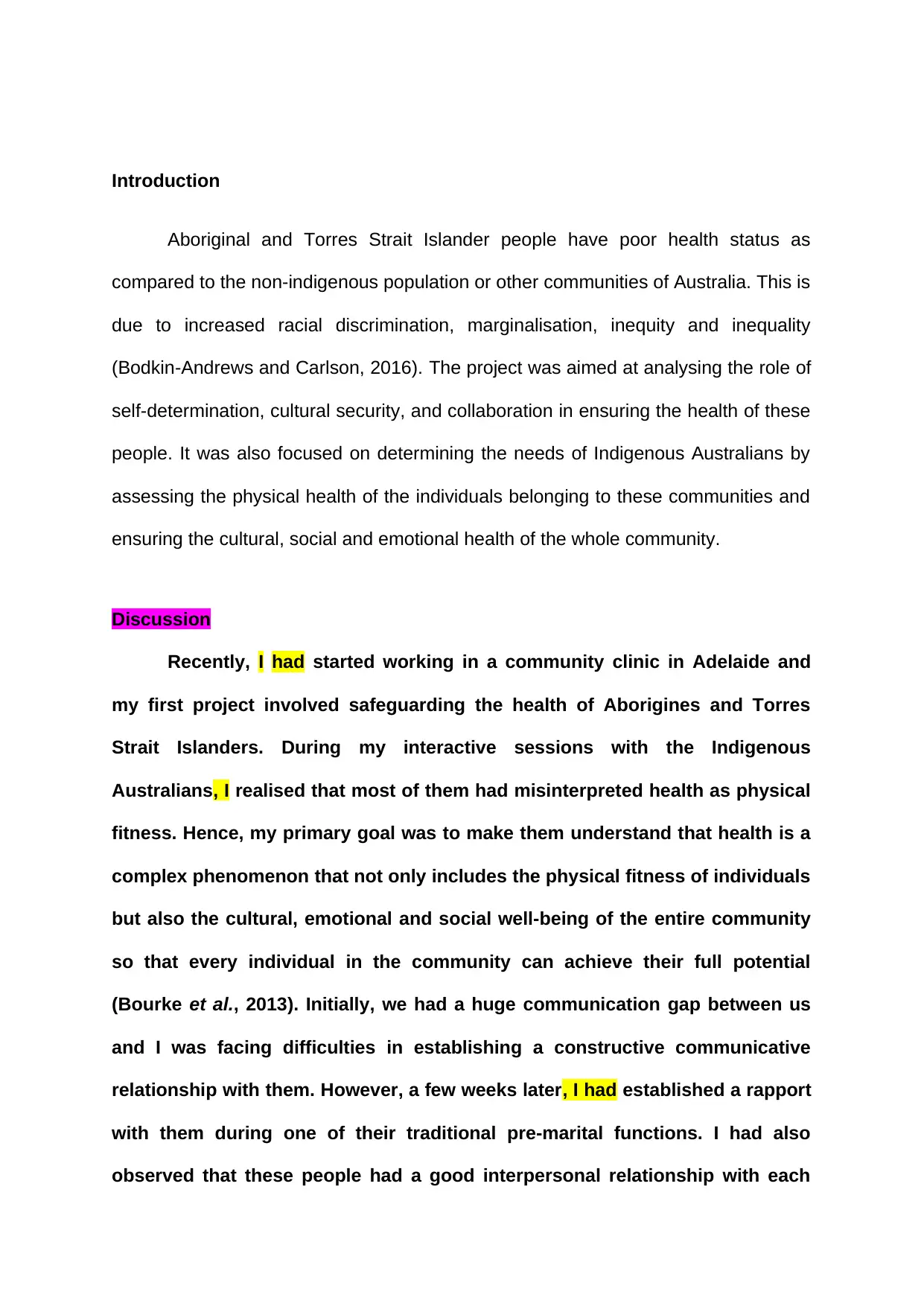
Introduction
Aboriginal and Torres Strait Islander people have poor health status as
compared to the non-indigenous population or other communities of Australia. This is
due to increased racial discrimination, marginalisation, inequity and inequality
(Bodkin-Andrews and Carlson, 2016). The project was aimed at analysing the role of
self-determination, cultural security, and collaboration in ensuring the health of these
people. It was also focused on determining the needs of Indigenous Australians by
assessing the physical health of the individuals belonging to these communities and
ensuring the cultural, social and emotional health of the whole community.
Discussion
Recently, I had started working in a community clinic in Adelaide and
my first project involved safeguarding the health of Aborigines and Torres
Strait Islanders. During my interactive sessions with the Indigenous
Australians, I realised that most of them had misinterpreted health as physical
fitness. Hence, my primary goal was to make them understand that health is a
complex phenomenon that not only includes the physical fitness of individuals
but also the cultural, emotional and social well-being of the entire community
so that every individual in the community can achieve their full potential
(Bourke et al., 2013). Initially, we had a huge communication gap between us
and I was facing difficulties in establishing a constructive communicative
relationship with them. However, a few weeks later, I had established a rapport
with them during one of their traditional pre-marital functions. I had also
observed that these people had a good interpersonal relationship with each
Aboriginal and Torres Strait Islander people have poor health status as
compared to the non-indigenous population or other communities of Australia. This is
due to increased racial discrimination, marginalisation, inequity and inequality
(Bodkin-Andrews and Carlson, 2016). The project was aimed at analysing the role of
self-determination, cultural security, and collaboration in ensuring the health of these
people. It was also focused on determining the needs of Indigenous Australians by
assessing the physical health of the individuals belonging to these communities and
ensuring the cultural, social and emotional health of the whole community.
Discussion
Recently, I had started working in a community clinic in Adelaide and
my first project involved safeguarding the health of Aborigines and Torres
Strait Islanders. During my interactive sessions with the Indigenous
Australians, I realised that most of them had misinterpreted health as physical
fitness. Hence, my primary goal was to make them understand that health is a
complex phenomenon that not only includes the physical fitness of individuals
but also the cultural, emotional and social well-being of the entire community
so that every individual in the community can achieve their full potential
(Bourke et al., 2013). Initially, we had a huge communication gap between us
and I was facing difficulties in establishing a constructive communicative
relationship with them. However, a few weeks later, I had established a rapport
with them during one of their traditional pre-marital functions. I had also
observed that these people had a good interpersonal relationship with each
Paraphrase This Document
Need a fresh take? Get an instant paraphrase of this document with our AI Paraphraser
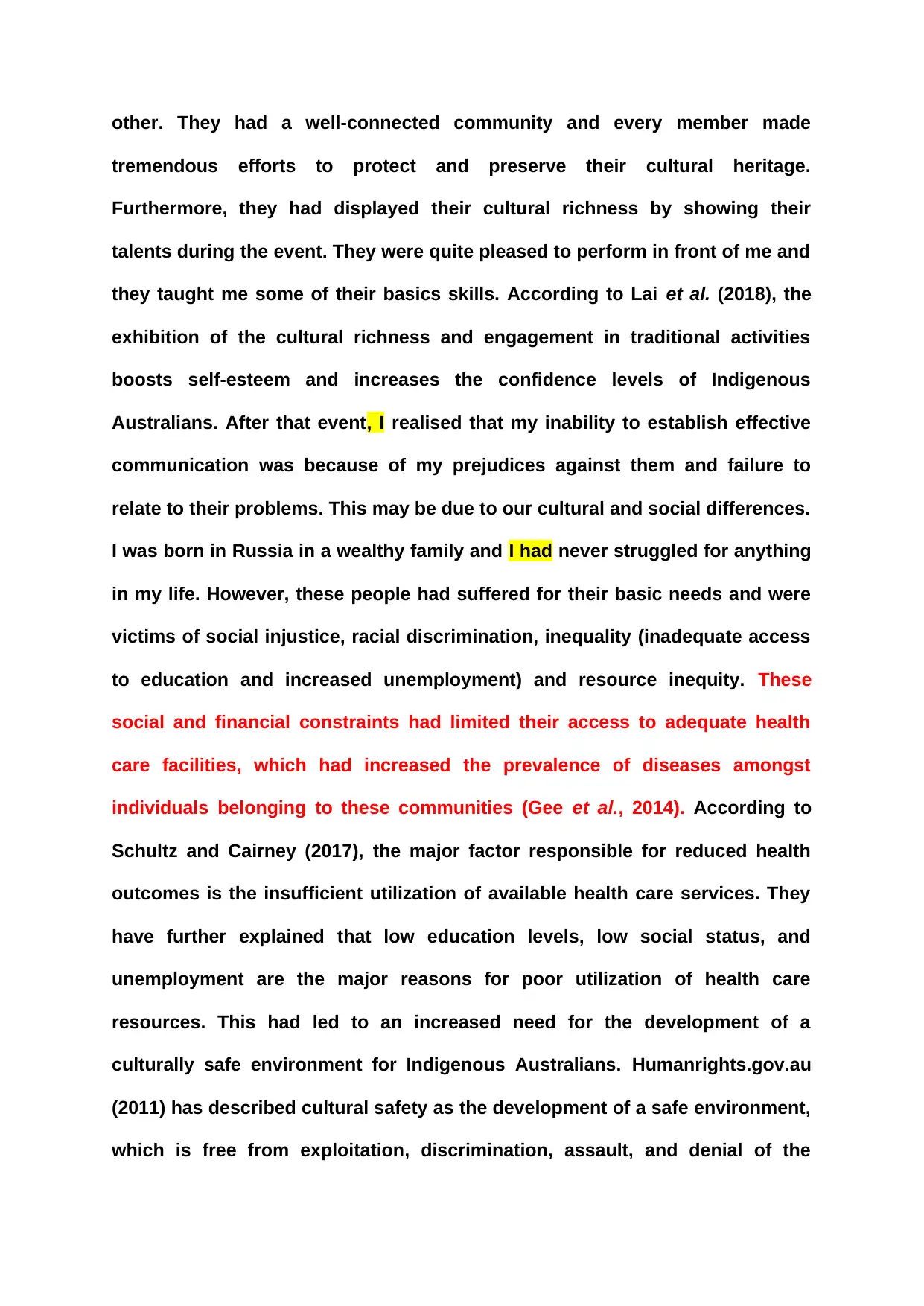
other. They had a well-connected community and every member made
tremendous efforts to protect and preserve their cultural heritage.
Furthermore, they had displayed their cultural richness by showing their
talents during the event. They were quite pleased to perform in front of me and
they taught me some of their basics skills. According to Lai et al. (2018), the
exhibition of the cultural richness and engagement in traditional activities
boosts self-esteem and increases the confidence levels of Indigenous
Australians. After that event, I realised that my inability to establish effective
communication was because of my prejudices against them and failure to
relate to their problems. This may be due to our cultural and social differences.
I was born in Russia in a wealthy family and I had never struggled for anything
in my life. However, these people had suffered for their basic needs and were
victims of social injustice, racial discrimination, inequality (inadequate access
to education and increased unemployment) and resource inequity. These
social and financial constraints had limited their access to adequate health
care facilities, which had increased the prevalence of diseases amongst
individuals belonging to these communities (Gee et al., 2014). According to
Schultz and Cairney (2017), the major factor responsible for reduced health
outcomes is the insufficient utilization of available health care services. They
have further explained that low education levels, low social status, and
unemployment are the major reasons for poor utilization of health care
resources. This had led to an increased need for the development of a
culturally safe environment for Indigenous Australians. Humanrights.gov.au
(2011) has described cultural safety as the development of a safe environment,
which is free from exploitation, discrimination, assault, and denial of the
tremendous efforts to protect and preserve their cultural heritage.
Furthermore, they had displayed their cultural richness by showing their
talents during the event. They were quite pleased to perform in front of me and
they taught me some of their basics skills. According to Lai et al. (2018), the
exhibition of the cultural richness and engagement in traditional activities
boosts self-esteem and increases the confidence levels of Indigenous
Australians. After that event, I realised that my inability to establish effective
communication was because of my prejudices against them and failure to
relate to their problems. This may be due to our cultural and social differences.
I was born in Russia in a wealthy family and I had never struggled for anything
in my life. However, these people had suffered for their basic needs and were
victims of social injustice, racial discrimination, inequality (inadequate access
to education and increased unemployment) and resource inequity. These
social and financial constraints had limited their access to adequate health
care facilities, which had increased the prevalence of diseases amongst
individuals belonging to these communities (Gee et al., 2014). According to
Schultz and Cairney (2017), the major factor responsible for reduced health
outcomes is the insufficient utilization of available health care services. They
have further explained that low education levels, low social status, and
unemployment are the major reasons for poor utilization of health care
resources. This had led to an increased need for the development of a
culturally safe environment for Indigenous Australians. Humanrights.gov.au
(2011) has described cultural safety as the development of a safe environment,
which is free from exploitation, discrimination, assault, and denial of the
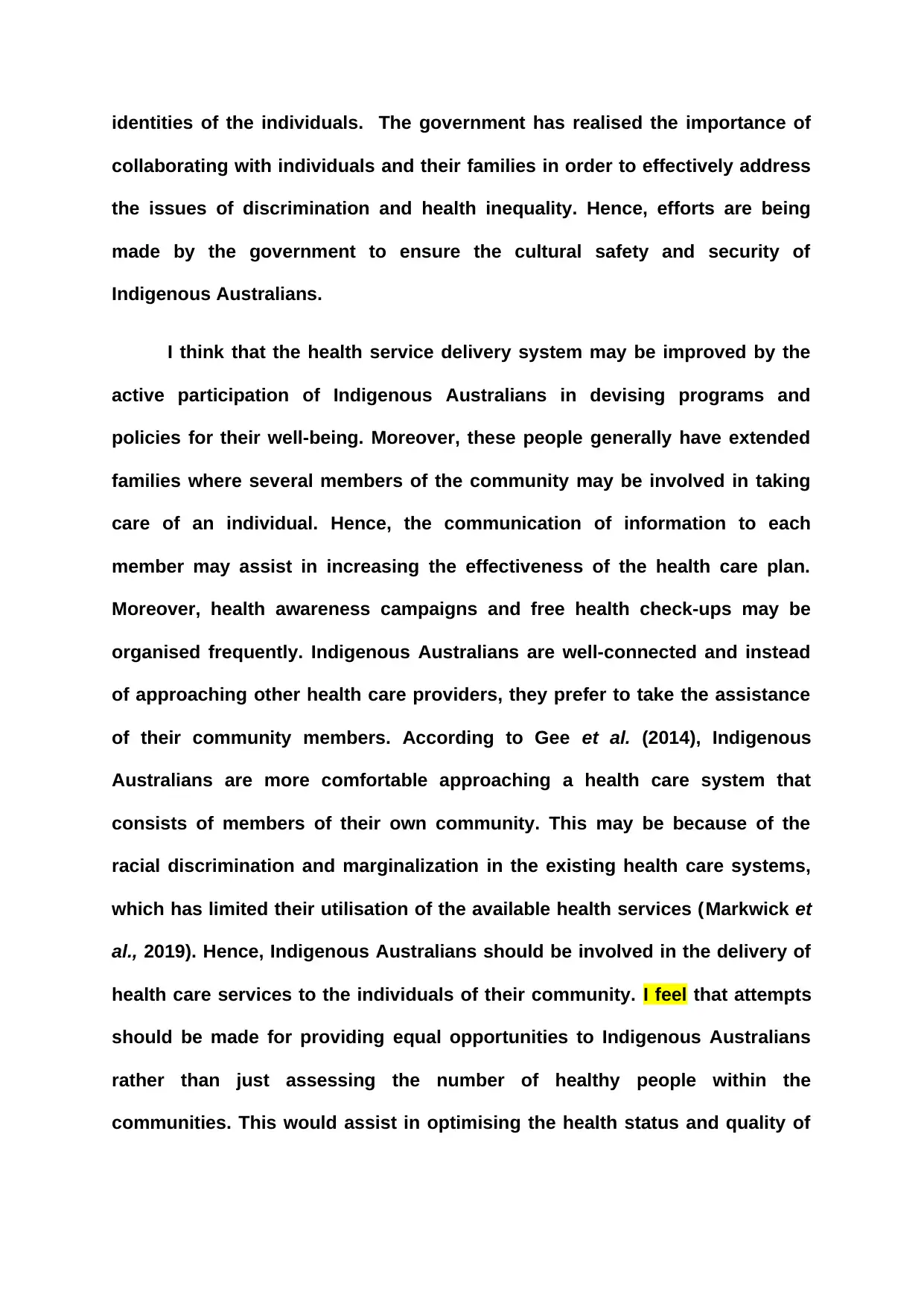
identities of the individuals. The government has realised the importance of
collaborating with individuals and their families in order to effectively address
the issues of discrimination and health inequality. Hence, efforts are being
made by the government to ensure the cultural safety and security of
Indigenous Australians.
I think that the health service delivery system may be improved by the
active participation of Indigenous Australians in devising programs and
policies for their well-being. Moreover, these people generally have extended
families where several members of the community may be involved in taking
care of an individual. Hence, the communication of information to each
member may assist in increasing the effectiveness of the health care plan.
Moreover, health awareness campaigns and free health check-ups may be
organised frequently. Indigenous Australians are well-connected and instead
of approaching other health care providers, they prefer to take the assistance
of their community members. According to Gee et al. (2014), Indigenous
Australians are more comfortable approaching a health care system that
consists of members of their own community. This may be because of the
racial discrimination and marginalization in the existing health care systems,
which has limited their utilisation of the available health services (Markwick et
al., 2019). Hence, Indigenous Australians should be involved in the delivery of
health care services to the individuals of their community. I feel that attempts
should be made for providing equal opportunities to Indigenous Australians
rather than just assessing the number of healthy people within the
communities. This would assist in optimising the health status and quality of
collaborating with individuals and their families in order to effectively address
the issues of discrimination and health inequality. Hence, efforts are being
made by the government to ensure the cultural safety and security of
Indigenous Australians.
I think that the health service delivery system may be improved by the
active participation of Indigenous Australians in devising programs and
policies for their well-being. Moreover, these people generally have extended
families where several members of the community may be involved in taking
care of an individual. Hence, the communication of information to each
member may assist in increasing the effectiveness of the health care plan.
Moreover, health awareness campaigns and free health check-ups may be
organised frequently. Indigenous Australians are well-connected and instead
of approaching other health care providers, they prefer to take the assistance
of their community members. According to Gee et al. (2014), Indigenous
Australians are more comfortable approaching a health care system that
consists of members of their own community. This may be because of the
racial discrimination and marginalization in the existing health care systems,
which has limited their utilisation of the available health services (Markwick et
al., 2019). Hence, Indigenous Australians should be involved in the delivery of
health care services to the individuals of their community. I feel that attempts
should be made for providing equal opportunities to Indigenous Australians
rather than just assessing the number of healthy people within the
communities. This would assist in optimising the health status and quality of
⊘ This is a preview!⊘
Do you want full access?
Subscribe today to unlock all pages.

Trusted by 1+ million students worldwide
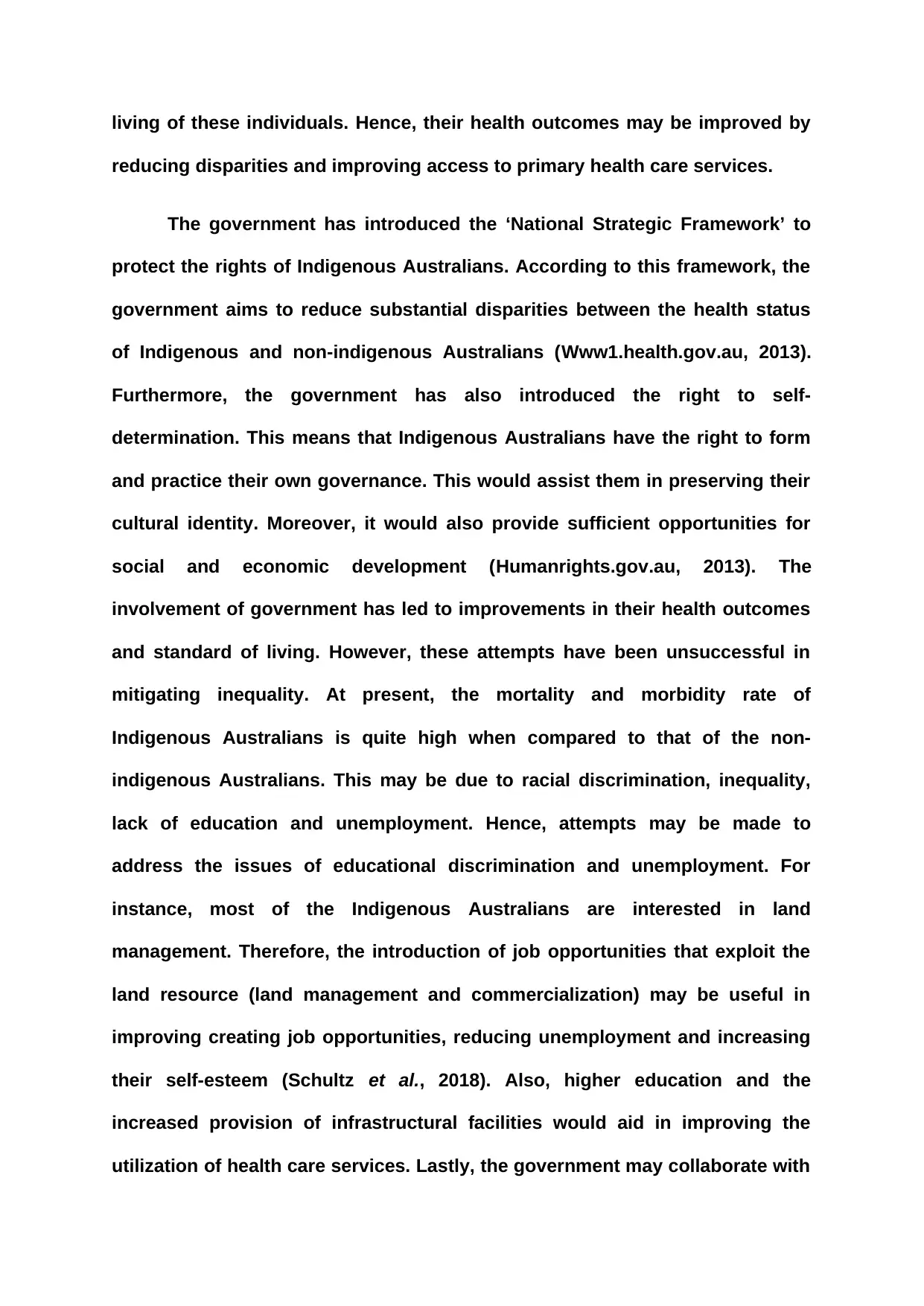
living of these individuals. Hence, their health outcomes may be improved by
reducing disparities and improving access to primary health care services.
The government has introduced the ‘National Strategic Framework’ to
protect the rights of Indigenous Australians. According to this framework, the
government aims to reduce substantial disparities between the health status
of Indigenous and non-indigenous Australians (Www1.health.gov.au, 2013).
Furthermore, the government has also introduced the right to self-
determination. This means that Indigenous Australians have the right to form
and practice their own governance. This would assist them in preserving their
cultural identity. Moreover, it would also provide sufficient opportunities for
social and economic development (Humanrights.gov.au, 2013). The
involvement of government has led to improvements in their health outcomes
and standard of living. However, these attempts have been unsuccessful in
mitigating inequality. At present, the mortality and morbidity rate of
Indigenous Australians is quite high when compared to that of the non-
indigenous Australians. This may be due to racial discrimination, inequality,
lack of education and unemployment. Hence, attempts may be made to
address the issues of educational discrimination and unemployment. For
instance, most of the Indigenous Australians are interested in land
management. Therefore, the introduction of job opportunities that exploit the
land resource (land management and commercialization) may be useful in
improving creating job opportunities, reducing unemployment and increasing
their self-esteem (Schultz et al., 2018). Also, higher education and the
increased provision of infrastructural facilities would aid in improving the
utilization of health care services. Lastly, the government may collaborate with
reducing disparities and improving access to primary health care services.
The government has introduced the ‘National Strategic Framework’ to
protect the rights of Indigenous Australians. According to this framework, the
government aims to reduce substantial disparities between the health status
of Indigenous and non-indigenous Australians (Www1.health.gov.au, 2013).
Furthermore, the government has also introduced the right to self-
determination. This means that Indigenous Australians have the right to form
and practice their own governance. This would assist them in preserving their
cultural identity. Moreover, it would also provide sufficient opportunities for
social and economic development (Humanrights.gov.au, 2013). The
involvement of government has led to improvements in their health outcomes
and standard of living. However, these attempts have been unsuccessful in
mitigating inequality. At present, the mortality and morbidity rate of
Indigenous Australians is quite high when compared to that of the non-
indigenous Australians. This may be due to racial discrimination, inequality,
lack of education and unemployment. Hence, attempts may be made to
address the issues of educational discrimination and unemployment. For
instance, most of the Indigenous Australians are interested in land
management. Therefore, the introduction of job opportunities that exploit the
land resource (land management and commercialization) may be useful in
improving creating job opportunities, reducing unemployment and increasing
their self-esteem (Schultz et al., 2018). Also, higher education and the
increased provision of infrastructural facilities would aid in improving the
utilization of health care services. Lastly, the government may collaborate with
Paraphrase This Document
Need a fresh take? Get an instant paraphrase of this document with our AI Paraphraser
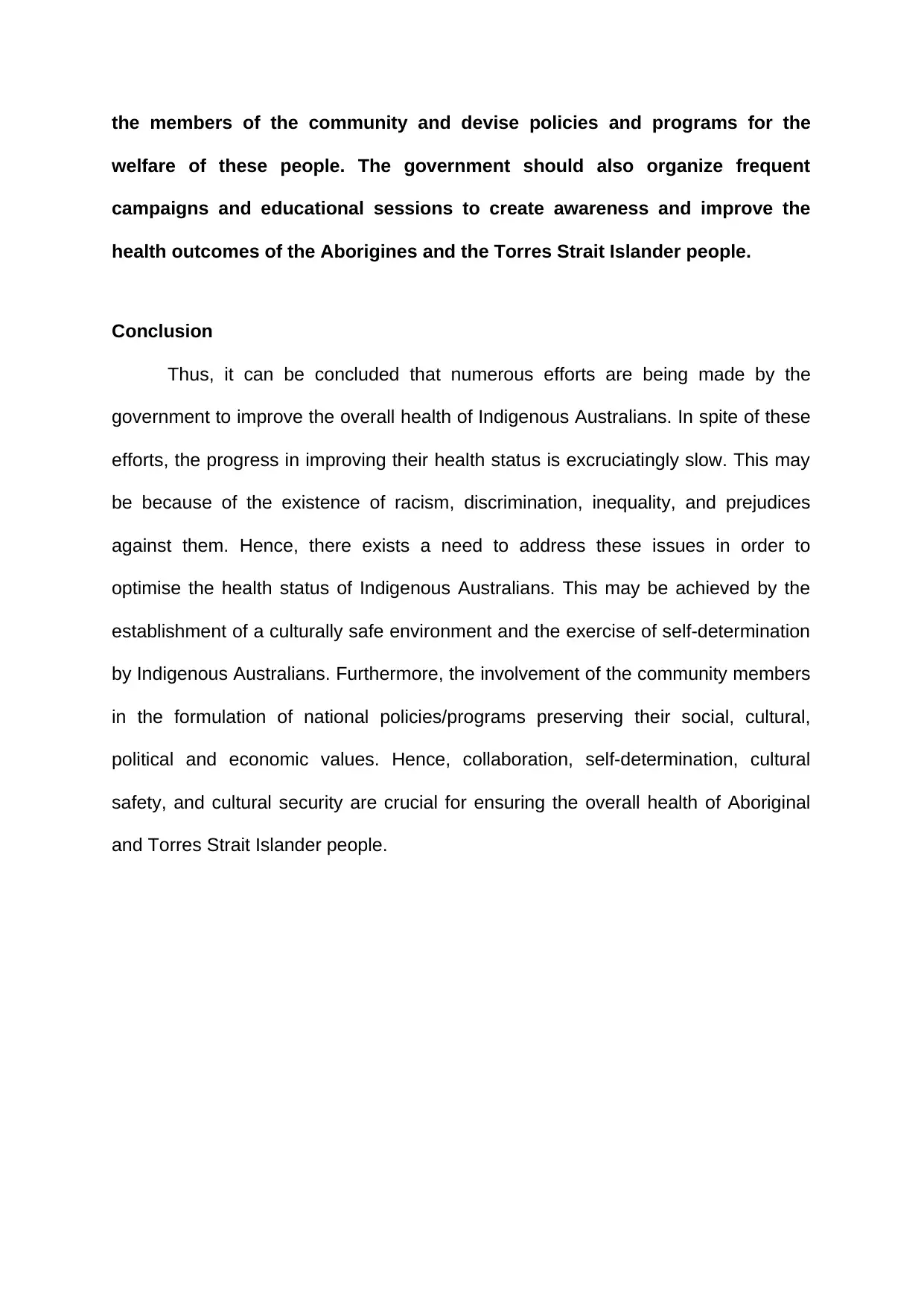
the members of the community and devise policies and programs for the
welfare of these people. The government should also organize frequent
campaigns and educational sessions to create awareness and improve the
health outcomes of the Aborigines and the Torres Strait Islander people.
Conclusion
Thus, it can be concluded that numerous efforts are being made by the
government to improve the overall health of Indigenous Australians. In spite of these
efforts, the progress in improving their health status is excruciatingly slow. This may
be because of the existence of racism, discrimination, inequality, and prejudices
against them. Hence, there exists a need to address these issues in order to
optimise the health status of Indigenous Australians. This may be achieved by the
establishment of a culturally safe environment and the exercise of self-determination
by Indigenous Australians. Furthermore, the involvement of the community members
in the formulation of national policies/programs preserving their social, cultural,
political and economic values. Hence, collaboration, self-determination, cultural
safety, and cultural security are crucial for ensuring the overall health of Aboriginal
and Torres Strait Islander people.
welfare of these people. The government should also organize frequent
campaigns and educational sessions to create awareness and improve the
health outcomes of the Aborigines and the Torres Strait Islander people.
Conclusion
Thus, it can be concluded that numerous efforts are being made by the
government to improve the overall health of Indigenous Australians. In spite of these
efforts, the progress in improving their health status is excruciatingly slow. This may
be because of the existence of racism, discrimination, inequality, and prejudices
against them. Hence, there exists a need to address these issues in order to
optimise the health status of Indigenous Australians. This may be achieved by the
establishment of a culturally safe environment and the exercise of self-determination
by Indigenous Australians. Furthermore, the involvement of the community members
in the formulation of national policies/programs preserving their social, cultural,
political and economic values. Hence, collaboration, self-determination, cultural
safety, and cultural security are crucial for ensuring the overall health of Aboriginal
and Torres Strait Islander people.

References
Bodkin-Andrews, G. and Carlson, B., 2016. The legacy of racism and Indigenous
Australian identity within education. Race Ethnicity and Education, 19(4), pp.784-
807.
Gee, G., Dudgeon, P., Schultz, C., Hart, A. and Kelly, K., 2014. Aboriginal and
Torres Strait Islander social and emotional wellbeing. Working together: Aboriginal
and Torres Strait Islander mental health and wellbeing principles and practice, 2,
pp.55-68.
Humanrights.gov.au, 2011. Chapter 4: Cultural safety and security: Tools to address
lateral violence - Social Justice Report 2011 | Australian Human Rights Commission .
Humanrights.gov.au. Available at: https://www.humanrights.gov.au/our-work/chapter-
4-cultural-safety-and-security-tools-address-lateral-violence-social-justice [Accessed
4 Oct. 2019].
Humanrights.gov.au, 2013. Right to self determination | Australian Human Rights
Commission. Humanrights.gov.au. Available at: https://www.humanrights.gov.au/our-
work/rights-and-freedoms/right-self-determination [Accessed 4 Oct. 2019].
Lai, G.C., Taylor, E.V., Haigh, M.M. and Thompson, S.C., 2018. Factors affecting the
retention of indigenous Australians in the health workforce: a systematic
review. International journal of environmental research and public health, 15(5),
p.914.
Markwick, A., Ansari, Z., Clinch, D. and McNeil, J., 2019. Experiences of racism
among Aboriginal and Torres Strait Islander adults living in the Australian state of
Victoria: a cross-sectional population-based study. BMC public health, 19(1), p.309.
Bodkin-Andrews, G. and Carlson, B., 2016. The legacy of racism and Indigenous
Australian identity within education. Race Ethnicity and Education, 19(4), pp.784-
807.
Gee, G., Dudgeon, P., Schultz, C., Hart, A. and Kelly, K., 2014. Aboriginal and
Torres Strait Islander social and emotional wellbeing. Working together: Aboriginal
and Torres Strait Islander mental health and wellbeing principles and practice, 2,
pp.55-68.
Humanrights.gov.au, 2011. Chapter 4: Cultural safety and security: Tools to address
lateral violence - Social Justice Report 2011 | Australian Human Rights Commission .
Humanrights.gov.au. Available at: https://www.humanrights.gov.au/our-work/chapter-
4-cultural-safety-and-security-tools-address-lateral-violence-social-justice [Accessed
4 Oct. 2019].
Humanrights.gov.au, 2013. Right to self determination | Australian Human Rights
Commission. Humanrights.gov.au. Available at: https://www.humanrights.gov.au/our-
work/rights-and-freedoms/right-self-determination [Accessed 4 Oct. 2019].
Lai, G.C., Taylor, E.V., Haigh, M.M. and Thompson, S.C., 2018. Factors affecting the
retention of indigenous Australians in the health workforce: a systematic
review. International journal of environmental research and public health, 15(5),
p.914.
Markwick, A., Ansari, Z., Clinch, D. and McNeil, J., 2019. Experiences of racism
among Aboriginal and Torres Strait Islander adults living in the Australian state of
Victoria: a cross-sectional population-based study. BMC public health, 19(1), p.309.
⊘ This is a preview!⊘
Do you want full access?
Subscribe today to unlock all pages.

Trusted by 1+ million students worldwide
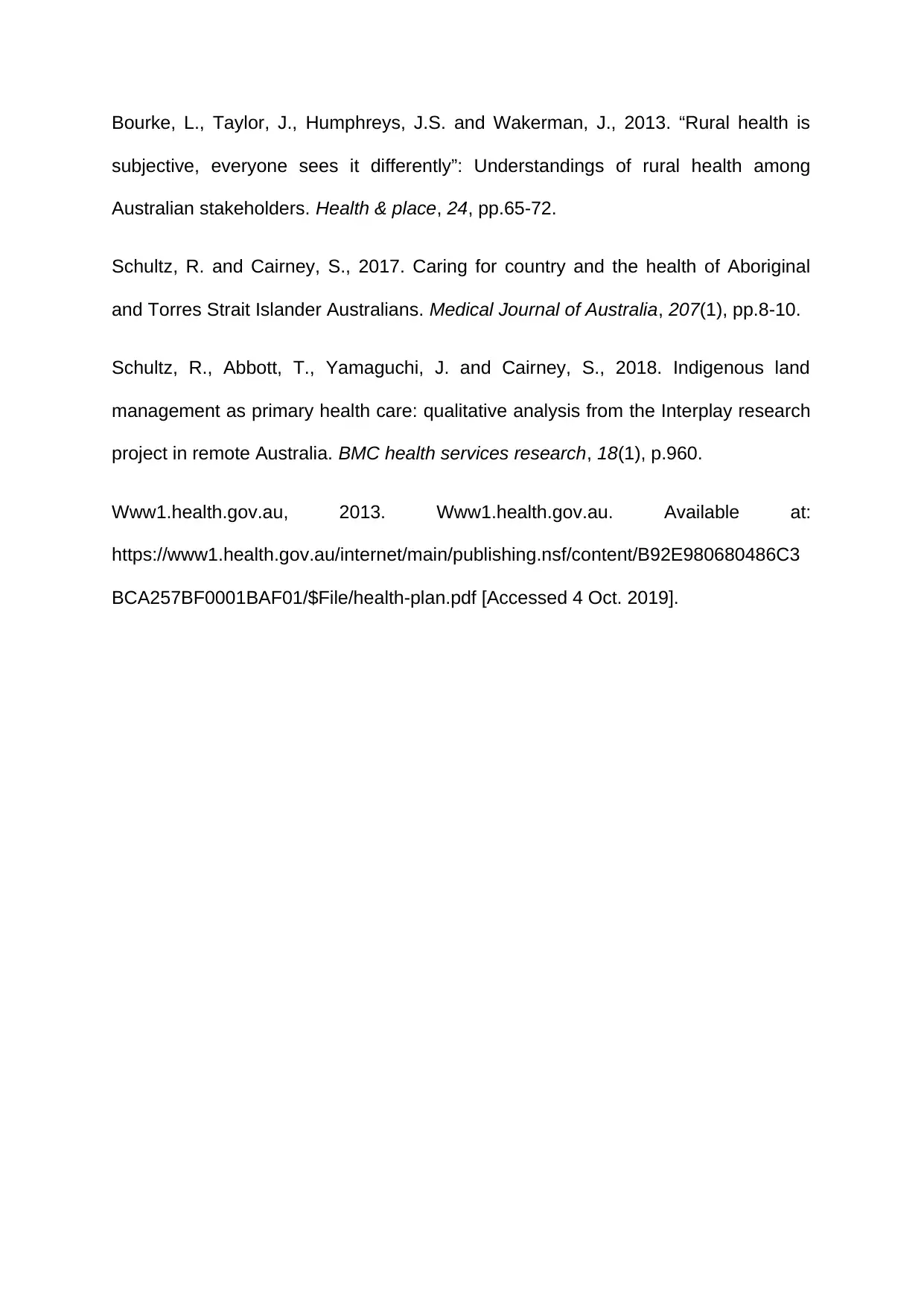
Bourke, L., Taylor, J., Humphreys, J.S. and Wakerman, J., 2013. “Rural health is
subjective, everyone sees it differently”: Understandings of rural health among
Australian stakeholders. Health & place, 24, pp.65-72.
Schultz, R. and Cairney, S., 2017. Caring for country and the health of Aboriginal
and Torres Strait Islander Australians. Medical Journal of Australia, 207(1), pp.8-10.
Schultz, R., Abbott, T., Yamaguchi, J. and Cairney, S., 2018. Indigenous land
management as primary health care: qualitative analysis from the Interplay research
project in remote Australia. BMC health services research, 18(1), p.960.
Www1.health.gov.au, 2013. Www1.health.gov.au. Available at:
https://www1.health.gov.au/internet/main/publishing.nsf/content/B92E980680486C3
BCA257BF0001BAF01/$File/health-plan.pdf [Accessed 4 Oct. 2019].
subjective, everyone sees it differently”: Understandings of rural health among
Australian stakeholders. Health & place, 24, pp.65-72.
Schultz, R. and Cairney, S., 2017. Caring for country and the health of Aboriginal
and Torres Strait Islander Australians. Medical Journal of Australia, 207(1), pp.8-10.
Schultz, R., Abbott, T., Yamaguchi, J. and Cairney, S., 2018. Indigenous land
management as primary health care: qualitative analysis from the Interplay research
project in remote Australia. BMC health services research, 18(1), p.960.
Www1.health.gov.au, 2013. Www1.health.gov.au. Available at:
https://www1.health.gov.au/internet/main/publishing.nsf/content/B92E980680486C3
BCA257BF0001BAF01/$File/health-plan.pdf [Accessed 4 Oct. 2019].
1 out of 7
Related Documents
Your All-in-One AI-Powered Toolkit for Academic Success.
+13062052269
info@desklib.com
Available 24*7 on WhatsApp / Email
![[object Object]](/_next/static/media/star-bottom.7253800d.svg)
Unlock your academic potential
Copyright © 2020–2025 A2Z Services. All Rights Reserved. Developed and managed by ZUCOL.




